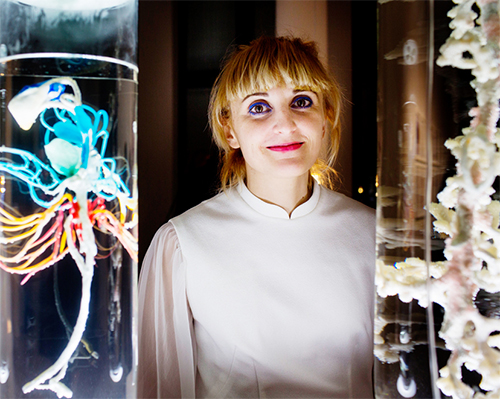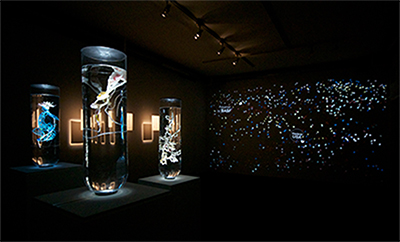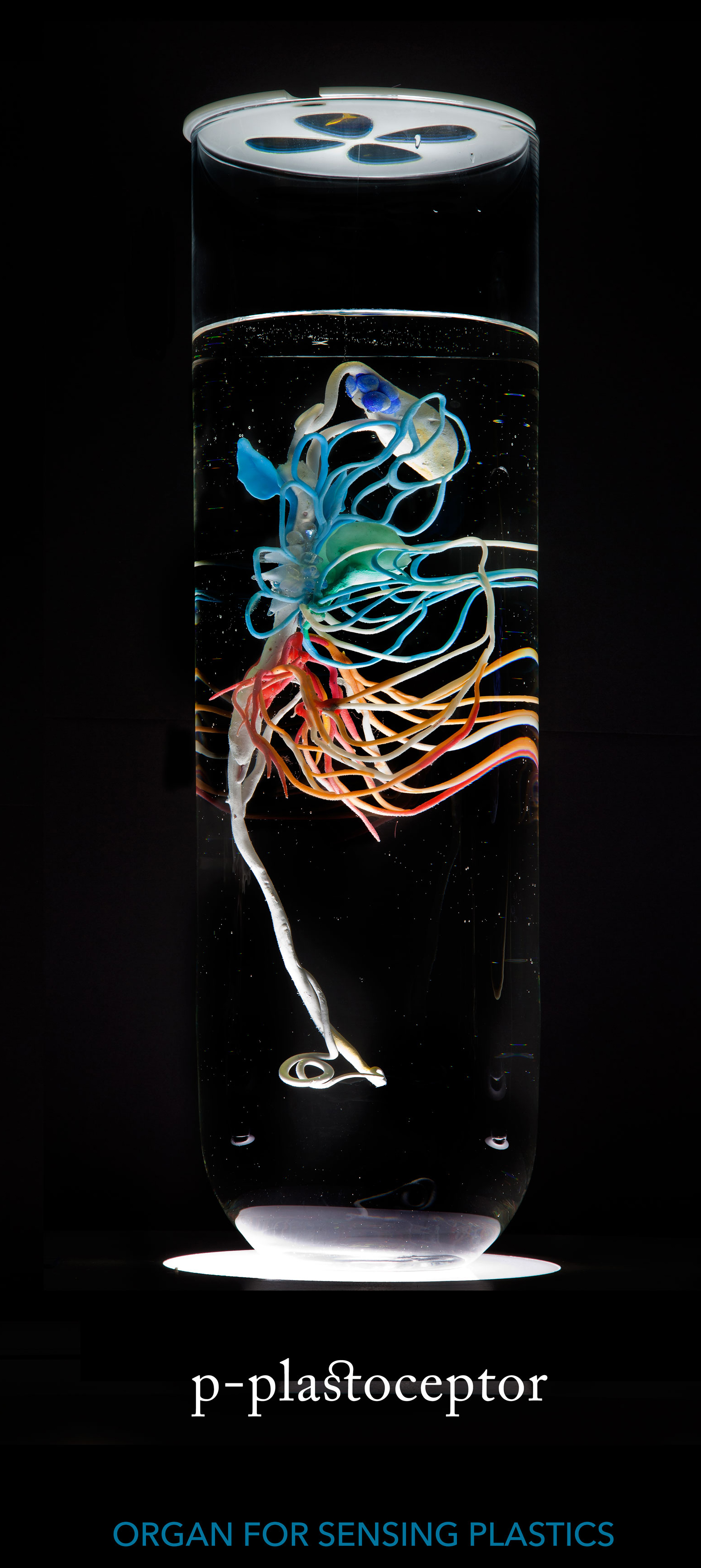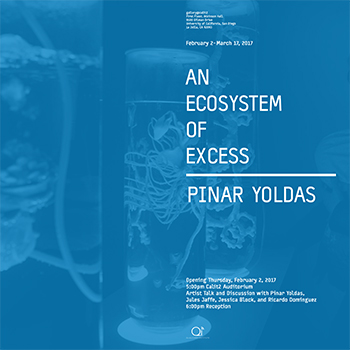Artist Offers Dystopic Vision of New Life Forms Emerging from Great Pacific Garbage Patch
"An Ecosystem of Excess" exhibition opens Feb. 2 in UC San Diego's gallery@calit2
San Diego, January 18, 2017 — Visitors to the gallery@calit2 on the University of California San Diego campus will be treated to a mind-expanding yet dystopic art show that asks a simple question: If life started today in our plastic debris-filled oceans, what kinds of life forms would emerge out of the contemporary primordial ooze?

With An Ecosystem of Excess – which runs from February 2 through March 17, 2017 -- artist Pinar Yoldas answers her own question with displays of speculative life forms, including pelagic insects, marine reptiles, fish and birds endowed with organs to sense and metabolize plastics, and much more. They represent “a new Linnean order of post-human life forms,” says Yoldas.
The exhibition will open on Thursday, February 2 at 5pm in the Qualcomm Institute’s gallery@calit2, located on the first floor of Atkinson Hall at UC San Diego. An artist talk by Pinar Yoldas and panel discussion featuring Scripps Institution of Oceanography research oceanographer Jules Jaffe, QI geologist Jessica Block, and Visual Arts professor (and moderator) Ricardo Dominguez (who chairs the QI Gallery Committee in 2016-2017). The panel will be followed by an opening reception. All activities are open to the public, free of charge.
Inspired by the groundbreaking findings of new bacteria that burrow into pelagic plastics, An Ecosystem of Excess envisions life forms of greater complexity that can thrive in man-made extreme environments – life forms that can “turn the toxic surplus of our capitalistic desire into eggs, vibrations, and joy,” observes Yoldas, who completed her Ph.D. in Media Arts and Sciences from Duke University in 2016. “Starting from excessive anthropocentrism, my work aims for anthropo-de-centrism by offering life minus mankind.” In 2008 Yoldas earned an MFA in New Media Art from UCLA (working in the Art|Sci Center and the UCLA Game Lab).

The artist’s work on speculative life forms draws on the biological sciences and digital technologies through architectural installations, kinetic sculpture, sound, video and drawing, with a focus on post-humanism, eco-nihilism, anthropocene as well as feminist technoscience.
Yoldas says the inspiration for her speculative biologies came from scientific and news reports about the Great Pacific Garbage Patch (originally dubbed a ‘trash vortex’ by sailor and environmental crusader Capt. Charles Moore after he encountered the rampant Pacific Ocean pollution in 1997). Covering between 700,000 and 15 million square kilometers, the site is a monument to plastic waste on a global scale after many years of unsustainable consumption around the Pacific Rim.

The Turkish-born, U.S.-based artist cites explorer and oceanographer Sylvia Earle, who called Earth a misnomer because the planet should really be called the Ocean. “After all,” explains Yoldas, “oceans are the life-support system of our planet as well as its salty wombs. The ancient ocean, the primordial soup, gave birth to the very first organic molecules and was brimming with prehistoric living organisms. That was four billion years ago. Today the composition of oceans is undergoing a dramatic change in which synthetic molecules are taking over. Anthropogenic waste has filled our oceans in less than two decades.”
Pinar Yoldas considers herself an ‘infradisciplinary’ designer/artist/researcher (infra as in ‘infrared’, she explains, where light goes beyond spectrum that is visible to the naked eye). The artist received a European Union-funded Future and Emerging Art and Technologies (FEAT) Award in 2016 to work with European scientists on novel technologies to convert carbon dioxide into something useful. In 2015, Yoldas received a John Simon Guggenheim Fellowship in the Fine Arts.
The artist’s solo shows have included The Warm, the Cool and the Cat at Sweden’s Röda Sten Art Center (2016), Polyteknikum Museum Moscow (2015), and An Ecosystem of Excess at Ernst Schering Project Space (2014), among many. Yoldas’s work has been exhibited in group shows including ThingWorld, NAMOC National Art Museum of Beijing (2014); Transmediale Festival, Berlin (2014); Polytech Museum, Moscow (2015), ExoEvolution at ZKM (2015), 14th Istanbul Biennial (2015) and the Taiwan National Museum of Fine Arts (2016).

Artist residencies held by Yoldas have included the MacDowell Colony, UCross Foundation, VCCA, National Evolutionary Synthesis Center, Duke University, Quartier21 Künstlerstudio-Programm, and a Transmediale Villem Flusser research residency at UdK Berlin, among others. She has been an invited speaker at SAIC, Haus der Kulturen der Welt, Northwestern University, Angewandte Kunst, University of Arizona, Reed College, University of Buffalo, BacNet15, Penn State and UCLA among many others, where her work has been featured by international print and electronic media including Arte TV, Die Welt, The Creators Project, Art21 Blog, Der Spiegel, Vogue Turkey and Artlink BioArt, to name a few.
In addition to her Ph.D. and MFA degrees from Duke and UCLA, respectively, Yoldas received an M.S. in Internet Technologies from Istanbul Technical University (2006), and an M.A. in Visual Communication Design from Istanbul Bilgi University (2004). Earlier, she completed her undergraduate degree in Architecture at Middle East Technical University in Ankara (2002).
Yoldas published “An Ecosystem of Excess” (Argobooks) in 2014 to coincide with the work’s first gallery exhibition at the Ernst Schering Project Space in Berlin the same year.
For more information about the gallery@calit2, contact Trish Stone at tstone@ucsd.edu.
Media Contacts
Doug Ramsey, (858) 822-5825, dramsey@ucsd.edu
Related Links
gallery@calit2
Pinar Yoldas Website
Pinar Yoldas Q&A in Guernica Magainze

